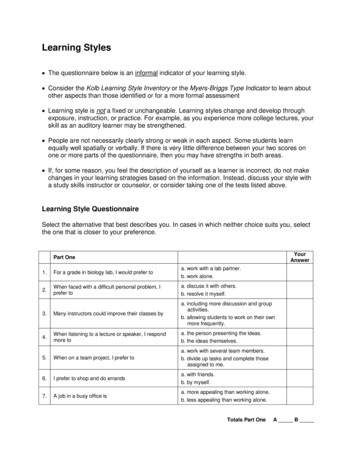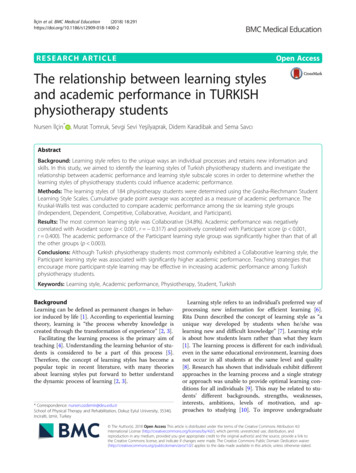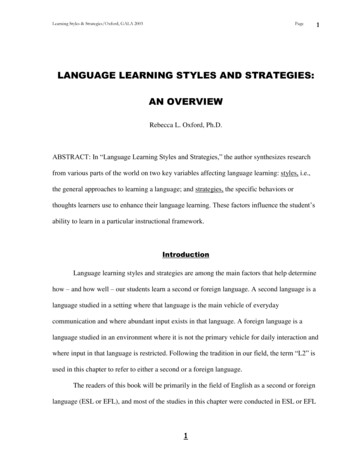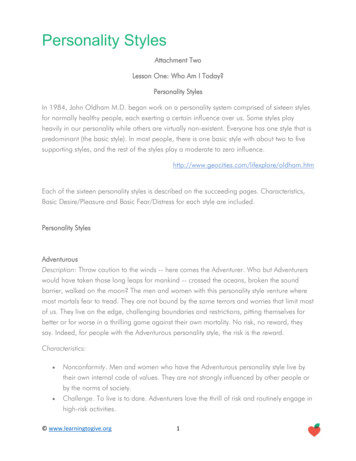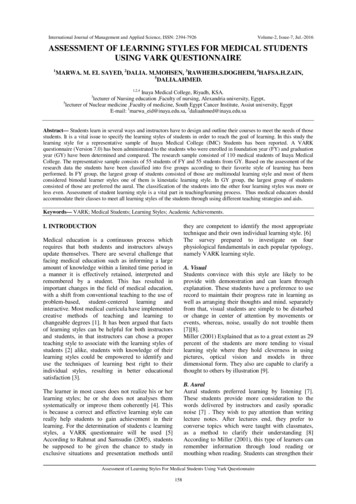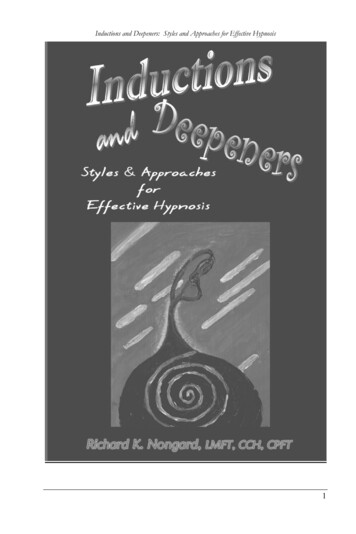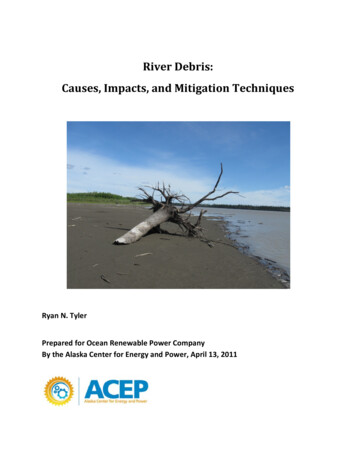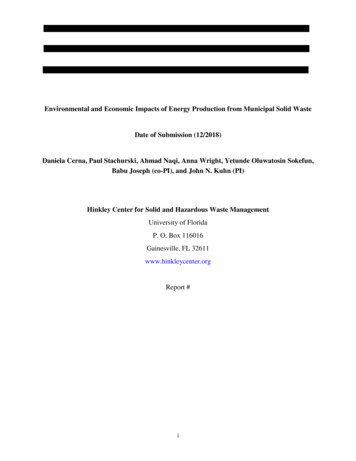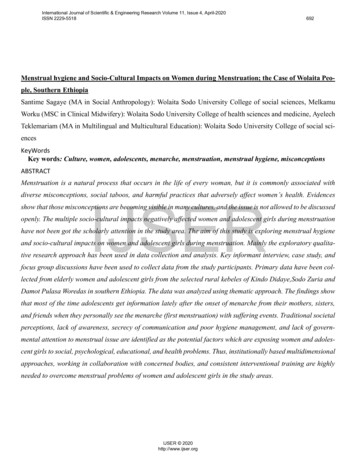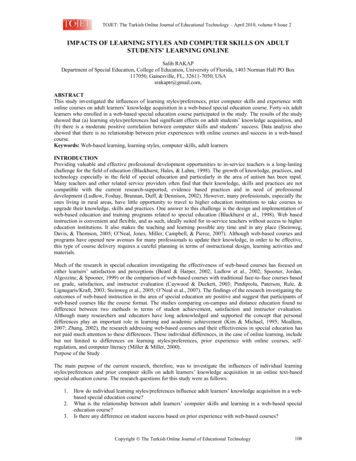
Transcription
TOJET: The Turkish Online Journal of Educational Technology – April 2010, volume 9 Issue 2IMPACTS OF LEARNING STYLES AND COMPUTER SKILLS ON ADULTSTUDENTS’ LEARNING ONLINESalih RAKAPDepartment of Special Education, College of Education, University of Florida, 1403 Norman Hall PO Box117050, Gainesville, FL, 32611-7050, USAsrakaptr@gmail.com,ABSTRACTThis study investigated the influences of learning styles/preferences, prior computer skills and experience withonline courses on adult learners’ knowledge acquisition in a web-based special education course. Forty-six adultlearners who enrolled in a web-based special education course participated in the study. The results of the studyshowed that (a) learning styles/preferences had significant effects on adult students’ knowledge acquisition, and(b) there is a moderate positive correlation between computer skills and students’ success. Data analysis alsoshowed that there is no relationship between prior experiences with online courses and success in a web-basedcourse.Keywords: Web-based learning, learning styles, computer skills, adult learnersINTRODUCTIONProviding valuable and effective professional development opportunities to in-service teachers is a long-lastingchallenge for the field of education (Blackhurst, Hales, & Lahm, 1998). The growth of knowledge, practices, andtechnology especially in the field of special education and particularly in the area of autism has been rapid.Many teachers and other related service providers often find that their knowledge, skills and practices are notcompatible with the current research-supported, evidence based practices and in need of professionaldevelopment (Ludlow, Foshay, Brannan, Duff, & Dennison, 2002). However, many professionals, especially theones living in rural areas, have little opportunity to travel to higher education institutions to take courses toupgrade their knowledge, skills and practices. One answer to this challenge is the design and implementation ofweb-based education and training programs related to special education (Blackhurst et al., 1998). Web basedinstruction is convenient and flexible, and as such, ideally suited for in-service teachers without access to highereducation institutions. It also makes the teaching and learning possible any time and in any place (Steinweg,Davis, & Thomson, 2005; O’Neal, Jones, Miller, Campbell, & Pierce, 2007). Although web-based courses andprograms have opened new avenues for many professionals to update their knowledge, in order to be effective,this type of course delivery requires a careful planning in terms of instructional design, learning activities andmaterials.Much of the research in special education investigating the effectiveness of web-based courses has focused oneither learners’ satisfaction and perceptions (Beard & Harper, 2002; Ludlow et al., 2002; Spooner, Jordan,Algozzine, & Spooner, 1999) or the comparison of web-based courses with traditional face-to-face courses basedon grade, satisfaction, and instructor evaluation (Caywood & Duckett, 2003; Pindiprolu, Paterson, Rule, &Lignugaris/Kraft, 2003; Steinweg et al., 2005; O’Neal et al., 2007). The findings of the research investigating theoutcomes of web-based instruction in the area of special education are positive and suggest that participants ofweb-based courses like the course format. The studies comparing on-campus and distance education found nodifference between two methods in terms of student achievement, satisfaction and instructor evaluation.Although many researchers and educators have long acknowledged and supported the concept that personaldifferences play an important role in learning and academic achievement (Kim & Michael, 1995; Moallem,2007; Zhang, 2002), the research addressing web-based courses and their effectiveness in special education hasnot paid much attention to these differences. These individual differences, in the case of online learning, includebut not limited to differences on learning styles/preferences, prior experience with online courses, selfregulation, and computer literacy (Miller & Miller, 2000).Purpose of the StudyThe main purpose of the current research, therefore, was to investigate the influences of individual learningstyles/preferences and prior computer skills on adult learners’ knowledge acquisition in an online text-basedspecial education course. The research questions for this study were as follows:1.2.3.How do individual learning styles/preferences influence adult learners’ knowledge acquisition in a webbased special education course?What is the relationship between adult learners’ computer skills and learning in a web-based specialeducation course?Is there any difference on student success based on prior experience with web-based courses?Copyright The Turkish Online Journal of Educational Technology108
TOJET: The Turkish Online Journal of Educational Technology – April 2010, volume 9 Issue 2Learning StylesThere has been a growing body of research investigating web-based instruction and its various aspects. However,the characteristics of learners who enroll in online programs have not been investigated extensively (Kelly &Schorger, 2002; Liu, 2007; Saba, 2000). Moreover, the relationship between web-based learning and learningstyles of individuals who enroll in online courses has received little attention in the literature (Harris, Dwyer, &Leeming, 2003). However, many researchers stated that in order to provide appropriate learning opportunities tostudents, improve their motivation and maximize their learning in web-based courses, it is important to identifytheir learning styles and adapt teaching methods that meet the diverse needs of learners (Drennan, Kennedy, &Pisarki, 2005; Hawk & Shah, 2007; Johnson, 2004; Wehrwein, Lujan, & DiCarlo, 2007). Research investigatingthe learning styles has mainly focused on comparing learning preferences of students who enrolled to online andtraditional courses and their academic achievement (Aragon, Johnson, & Shaik, 2000; Buerk, Malmstrom, &Peppers, 2003; Downing & Chim, 2004; Garland, 2003; Halsne & Gatta, 2002; Liu, 2007; Manochehri &Young, 2006). The result of these studies is non-conclusive. Only in two studies, the researchers examined therelationship between learning styles and academic performance. Bozionelos (1997) reported that students with aparticular learning style (i.e., active experimentation model) performed better than their classmates with otherlearning preferences in an online course. Harris et al. (2003) found that individual learning styles did notinfluence students’ mean test scores. However, participants of these studies were either undergraduate orgraduate students and there is no study found in the literature that focused on examining the relationship betweenadult students’ learning preferences and academic achievement in online courses.Many different learning styles/preferences and definitions of learning styles exist in the literature. Keefe (1979)defines learning styles as typical psychological, cognitive and affective behaviors that serve as reasonably stableindicators of how individuals perceive, respond to and interact with learning environments. Reid (1995)characterizes learning style as favored ways of taking in, processing and maintaining new information and skills.Fleming (2001) defines learning style as “an individual’s preferred ways of gathering, organizing, and thinkingabout information (p.1). As parallel with variation on its definition, there are many different methods forassessing learners learning styles. One of the commonly used learning style/preference inventory, the VARKQuestionnaire (Fleming, 2001), is used in the current study. VARK stands for visual (V), aural (A), read/write(R) and kinesthetic (K) learning preferences. Learners with visual learning preference learn best by observing,watching and seeing. Aural learners learn through listening, discussing and talking. Read/Write type learnerslearn best by interacting with textual materials. Learners with kinesthetic learning preference learn best by doing.Table 1 provides the learning activities offered by Fleming (2001) to support each learning style. Additionalinformation about the VARK Questionnaire is provided in the Methods section.VisualTable 1: Learning activities to support each VARK learning esVideosFlow chartsDifferent ussionsteacher/ tbookReadings/ ArticlesHandouts/ NotesWritten ssariesHands-on experiencesModelingRole playPhysical activitiesGuest lecturersReal-life experiencesDemonstrationsSource: www.vark-learn.comComputer SkillsComputer skills and comfort with different technological applications are considered essential components ofstudent success when the courses are offered online (Erlich, Erlich-Philip, & Gal-Ezer, 2005; Jameson &McDonnell, 2007; Martz & Reddy, 2005, Shih, Munoz, & Sanchez, 2006; Summers, Waigandt, & Whittaker,2005). However, several researchers have claimed that computer skills have little or no impact on studentsuccess and participation (McIsaac, Blocker, Mahes, & Vrasidas, 1999; Rumprapid, 1999). Since the results ofthese researchers is not convincing, there is a need for further investigation of this relationship. In addition,these studies have been conducted with either college or graduate student and no previous research examiningthe relationship between adult learners’ computer skills and knowledge acquisition is identified in the literature.Copyright The Turkish Online Journal of Educational Technology109
TOJET: The Turkish Online Journal of Educational Technology – April 2010, volume 9 Issue 2Course FormatThe Department of Special Education in a southeastern university has been offering a series of courses that uponcompletion will allow special education teachers to obtain the Autism Endorsement through the state’s teachercertification office. The series consists of 4 web-based courses Teachers who participate in the project completeonline program in one year.The present study was conducted in their first semester in the program when students took a course focusing onintervention techniques to support communication and social development of students with autism in theSummer 2008 semester. This course was designed to prepare educators to understand the communication andsocial skills of individuals with autism. The focus of the course was on the classroom-based strategies forpromoting effective communication through the use of assistive technology and augmentative and alternativecommunication. The course was delivered asynchronously and utilized a text-based format.The course consisted of six modules. One topic in each module was introduced and covered each week. Theobjectives of the module, an introduction and a power point presentation were provided at the beginning of eachmodule. Students were assigned readings, given a quiz and an assignment in each module. The assignmentsprovided students with the opportunities to apply the knowledge they acquired through readings, classpresentations and discussions. The students also participated in threaded discussions related to the module.Threaded discussions were asynchronous and available 24 hours per day during the module periods. Thesediscussions provided students with opportunities to interact with each other and the instructor. The instructordeveloped at least one activity or course material to address different needs of each learner. The course modeland delivery of instruction is illustrated in Figure 1.Figure 1. The course model and delivery of instructionCopyright The Turkish Online Journal of Educational Technology110
TOJET: The Turkish Online Journal of Educational Technology – April 2010, volume 9 Issue 2METHODSParticipantsFollowing their acceptance into the program, registered students were asked to complete consent forms and abackground information form if they agreed to participate in the current study. As a result, a total of 46 studentsagreed to participate in this study. Participants’ demographic information and information regarding theircomputer skills is presented in Table 2.Table 2: Demographic Characteristics of blesLearning StylesComputer 1151264.324.032.626.113.0Online Course ExperienceNo prior coursePrior course .7Ethnicity20-3031-4040-5050 Total for each Variable913141019.628.330.421.7African AmericanCaucasianHispanic23864.382.713.046100Total for each Variable46100InstrumentsInstruments used in this study include a background information survey, the VARK questionnaire, and SelfEvaluation of Technology Use survey.Evaluation of learning styles: The VARK learning preference questionnaire was selected to evaluate learningpreference of adult students because it is very easy and quick to complete and available online. The VARKincludes 13 multiple-choice questions to examine four different modalities (i.e., Visual, Aural, Read/Write, andKinesthetic). In each question, respondents are placed in a real life learning situation, offered four options andasked to choose option(s) which best characterizes their way of learning. Respondents are allowed to choosemore than one option if necessary or omit a question if no responses apply. As a result of evaluation of anindividual’s responses to the questionnaire, a person might have a single learning preference known as unimodal, or more than one learning preference known as multimodal (see Figure 2 for conceptual model).Subcategories of multimodal learning preference include bi-modal (having two learning preference) tri-modal(having three learning preference) or quad-modal (having four l
19.09.2008 · IMPACTS OF LEARNING STYLES AND COMPUTER SKILLS ON ADULT STUDENTS’ LEARNING ONLINE Salih RAKAP Department of Special Education, College of Education, University of Florida, 1403 Norman Hall PO Box 117050, Gainesville, FL, 32611-7050, USA srakaptr@gmail.com, ABSTRACT This study investigated the influences of learning styles/preferences, prior computer
